We will only sell American flags that are proudly made in America.
The American flags we sell are:
- Made with materials created and sourced in America.
- Passed through the hands of American employees.
- Produced in factories proudly stationed on American soil.
Click Here for Flag Etiquette & FAQs.
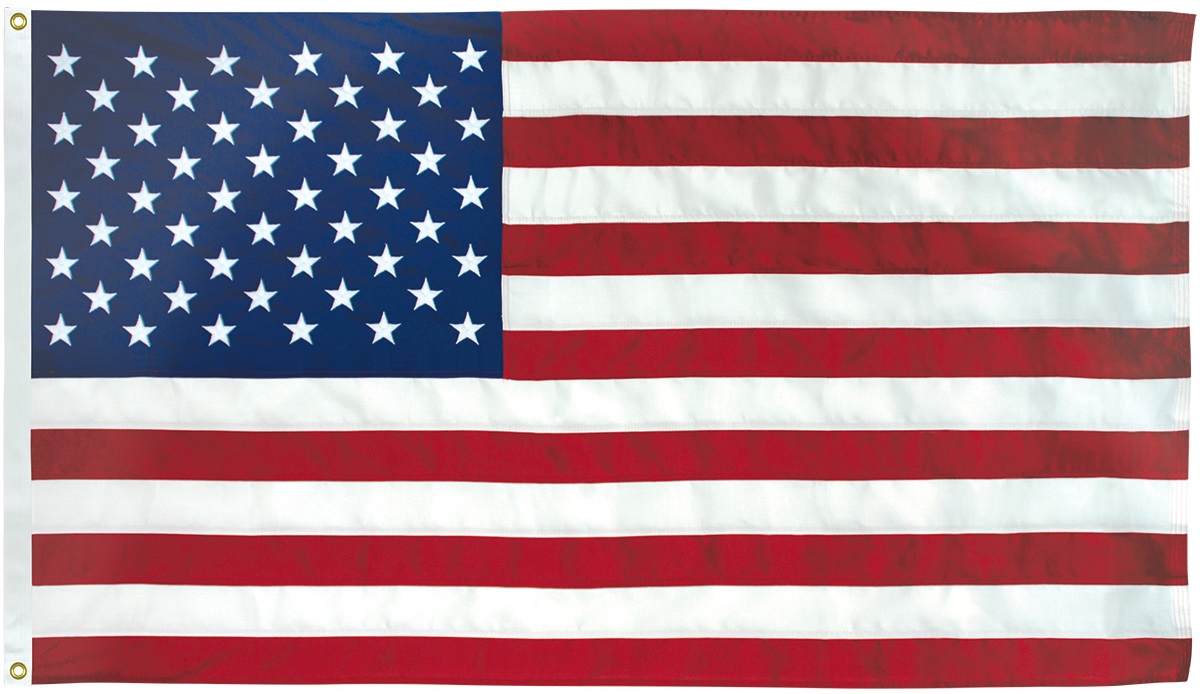
Outdoor American Flags
| Size | Nylon | Polyester |
| 2x3' | $26.90 | N/A |
| 2½x4' | $33.70 | N/A |
| 3x5' | $43.60 | $54.70 |
| 4x6' | $57.00 | $76.70 |
| 5x8' | $88.20 | $119.40 |
| 6x10' | $129.00 | $179.00 |
| 8x12' | $239.00 | $303.00 |
| 10x15' | $374.00 | $466.00 |
| 10x19' | $421.00 | $538.00 |
| 12x18' | $4510.00 | $633.00 |
| 15x25' | $850.00 | $1150.00 |
| 20x30' | $1130.00 | $1750.00 |
| 20x38' | $1320.00 | $1960.00 |
Nylon American Flags
- Excellent Durability.
- Made from fade resistant Aniline-dyed 100% heavyweight 200-denier nylon flag bunting.
- The close weave material enables the flag to fly in the slightest breeze giving the fullest visual effect.
- Quick-drying makes them great for rainy areas.
Polyester American Flags
- Best Durability.
- Made from 100% 2-ply polyester flag bunting.
- Open weave construction reduces wind resistance to increase flag life.
- Extreamely durable for commercial applications and high wind areas.
American Flag Construction
- Made with sewn stripes using double-needle stitching with premium quality thread.
- Finished with heavy-duty white cotton-polyester canvas headings.
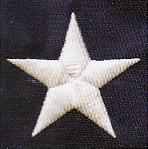
12x18 FT and smaller flags have embroidered white stars.
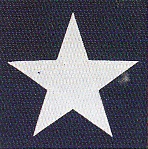
15x25 FT and larger flags have appliqued white nylon stars.
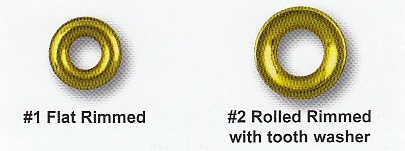
Grommets are solid brass. 12x18 Inch flags have #1 grommets. 16x24 Inch and larger flags have #2 grommets.
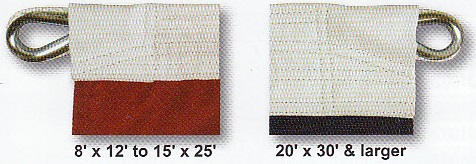
8x12 FT flags and larger include plated steel rope thimbles. Thimbles are attached to white rope using a triple crimped rope sleeve. The rope is sewn into the header to stabilze its position and prevent bunching.
Fly Hem Stitching Details
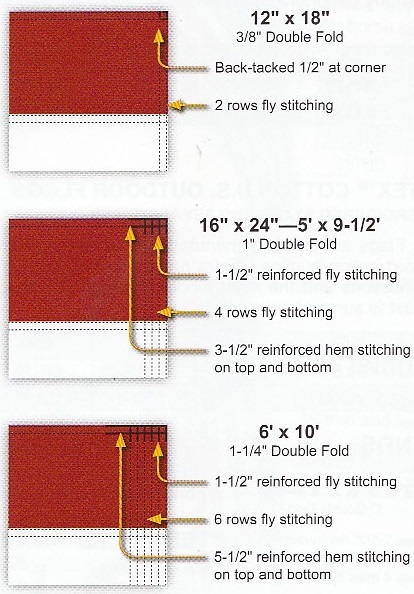
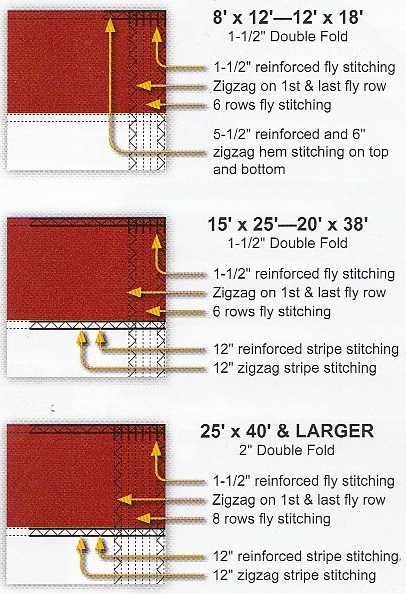
Determining Flag Size
This guide applies primarily to inground flagpoles 20' and taller.
The size of the flagpole is what usually determines the correct size flag you should fly. Flag manufacturers recommend that the length of the flag should be at least one-forth the height of the flagpole.
Examples: A 20' flagpole should have at least a 3x5' flag (20' flagpole divided by 4 equals 5 or a 3x5' flag). A 40' flagpole should have at least a 6x10' flag (40' flagpole divided by 4 equals 10 or a 6x10' flag).
Most residential flags are 3x5' or 4x6'. Most small commercials buildings will use a 5x8' or 6x10' flag. Larger buildings may require an 8x12' flag or larger.
You may always fly a larger flag than what is recommended. However, be aware that "over flagging" a flagpole may cause damage to the flagpole or break the halyard (rope) during high winds. If you wish to fly an extra large flag we recommend that you fly a Nylon flag since it weighs less than a Polyester flag, especially when wet. But flying a Nylon flag is still no guarantee that your flagpole will not be damaged during high winds.
Suggested Flag Size Examples:
- 20' Flagpole - 3x5' Flag
- 25' Flagpole - 4x6' Flag
- 30' Flagpole - 5x8' Flag
- 35' Flagpole - 6x10' Flag
- 40' Flagpole - 8x12 Flag
- 45' Flagpole - 8x12' Flag
- 50' Flagpole - 10x15' Flag
- 60' Flagpole - 12x18' Flag
- 70' Flagpole - 15x25' Flag
- 80' Flagpole - 20x30' Flag
Flag Care
The flags we sell are manufactured using the highest quality U.S. made materials available. They give exceptional service in exchange for reasonable care. Wind, water, sun, dirt and neglect are the major enemies of a flag. No one can control the weather but you can take some important steps to extend the life of your flag.
- Periodically gently wash your flag in cool water with mild detergent. Line dry or flat dry thoroughly to prevent mildew. If wrinkled, use the appropriate heat setting on your iron for the type of flag fabric.
- At the first sign of fraying have your flag re-hemmed before further damage is done. Extremely torn of frayed flags should be disposed of properly following the U.S. Flag Code.
- Always keep your flagpole as clean as possible. Move your pole if your flag does not have adequate room to fly unobstructed.
- To extend the life of your flag we recommend having two flags and rotate them regularly, like every month. This gives the flag a chance to "rest". It also give you a chance to inspect your flag, flagpole, halyard (rope) and flag snaps. With two flags, one flag can be on display while the other is resting or out for re-hemming.
How Long Will A Flag Last?
This is a difficult question with no exact answer. One extremely winding day can damage a brand new flag made from the best flag material.
My experiences have found that a good quality outdoor flag, when properly displayed and maintained, will last 6 months to a year and possible longer. But I have seen flags that are not cared for worn out less than 30 days.
Winter months are much harder on flags then summer months. And larger flags tend to wear out faster.
Nylon and polyester flags are best for outdoor use with polyester being best for high-wind areas. In my option cotton flags should only be used for parade use or for indoor use when they are displayed out of direct sunlight. Cotton flags tend to fade very quickly from sunlight, in some cases in as little as 30 days.
If your flagpole is light-weight in design, such as a telescoping or sectional aluminum residential flagpole, I suggest flying a nylon flag. They weigh less then a polyester flag and will put less stress on your flagpole in high winds.
When your flag shows the first sign of wear have it repaired as soon as possible. We will cut-off a frayed fly hem and re-hem it at no-charge. The flag will become shorter in length so the sooner you have it re-hemmed the less will need to be cut off.
When your flag is ready for retirement PLEASE DO NOT PLACE YOUR FLAG IN THE TRASH. We collect US flags for a proper retirement. The boy scouts are kind enough to pick them up regularly from us and give them a proper retirement.
The following is a copy of the flag care insert that a major flag manufacturer includes with their larger flags.
One of the most often asked questions about flags is "How long will an outdoor flag last"?
To help you understand this question, please consider the following facts. Weather, airborne contaminations and treatment of a flag, all play a major role in preservations or demise. Major enemies of all flags are wind, water, and sun; however, the single greatest cause of flag deterioration is CARELESSNESS. We cannot control the weather, but we can take care of the flag and the length of its life. When a snow, ice, sleet, freeing rain or high wind storm approaches, it is essential to take the flag down BEFORE the storm. Do not raise the flag until the storm has passed. Premature wear and tear of your flag could happen if the flag is left up during the storm including ripping and tearing.
Our flag are manufactured to give maximum service in return for reasonable care and sensible use. No two flags receive identical wear. Weather conditions vary and so does the life of each flag.
The best way we know how to stretch your flag dollar is to follow the above advice. You can also occasionally wash the flag in warm mild-detergent water, and let the flag air dry thoroughly before storing. Always have a flag repaired at the first sign of fraying and have back-up flags, rotating them often.

